Recent Storm Damage Posts
Be Prepared for Spring Storms
3/15/2021 (Permalink)
Severe Weather Preparedness Can Help Minimize Storm Damage to Your Property
Throughout the Midwest, Northern Illinois, the Chicagoland suburbs, we experience winter and spring much the same, but there is a good chance there are still great differences among the different areas.
Specifically here in the North Shore suburbs where SERVPRO of Glenview calls home, we may see snow as late as April, yet we may see temps in the 70s before St. Patrick's Day! The transition from winter to spring here in Glenview, Northbrook, and surrounding areas can be a volatile one indeed.
And few things are more volatile than severe weather in the spring! Severe weather is not something we can stop or control. From thunderstorms to lightning, tornadoes to floods, we cannot control when or where they develop or strike. However, there are things we can do to minimize the impact of severe weather. Protecting your family and your property begins with staying informed, having an emergency plan in place, and preparing yourself and your home or business for an emergency.
- Stay informed! Have various means of being alerted of severe weather in your area! Monitor a weather alert radio. Listen to local radio broadcasts. Watch local TV. Follow NWS (National Weather Service) web pages and apps for updates. Sign up for and receive alerts and notifications from various weather apps on your computer and smart phone. The important thing is to NOT rely on just one method! Even though storm sirens are a great alert system, they are not designed to be heard indoors by everyone.
- Have an emergency plan! Whether at home, at work, or at school, or when you travel, there should be an emergency evacuation plan in place. Not only should there be a plan - but you should practice your plan too! Designate places to go to seek safe shelter from a tornado or severe thunderstorm. Pick two places to meet, in case the first is not available or accessible - and meet your family, friends, or co-workers there in case you are separated. If you are traveling, know the names of locations you are visiting - and make sure your children know them too.
- Prepare yourself AND your home for an emergency! Inspect your home for potential hazards (such as weakened tree limbs, worn roofing, cracked windows, improper landscape grading) and address these issues before storms magnify the damage. When you build a new structure or renovate an existing one, there are ways to prevent wind damage to roofs, upper floors, and garages. Rafters, trusses, walls, and doors can all be reinforced. Learn how to react in an emergency: learn how to administer CPR; learn how to use a fire extinguisher; learn how to turn off the electricity, gas, and water supplies in your home.
Everything boils down to that old scouts' motto: BE PREPARED!
Be prepared and take steps to be fully informed about the dangers of severe weather in the area you call home. Put that knowledge to use and create an emergency plan for yourself and your family, for home, school, or work. And prepare your property with thorough inspection for potential hazards and addressing those issues.
Knowing that you have prepared your home to fare through spring's severe weather will help to minimize the damage should your home be faced with storm damage, be it water damage or wind damage.
If your home or business is impacted by spring's severe weather, call on the professionals at SERVPRO of Glenview to mitigate, cleanup, and restore your property. Call us at 847-832-9300. We are Ready for Whatever Happens.
Tips to Help Prevent Pipes From Bursting
2/3/2021 (Permalink)
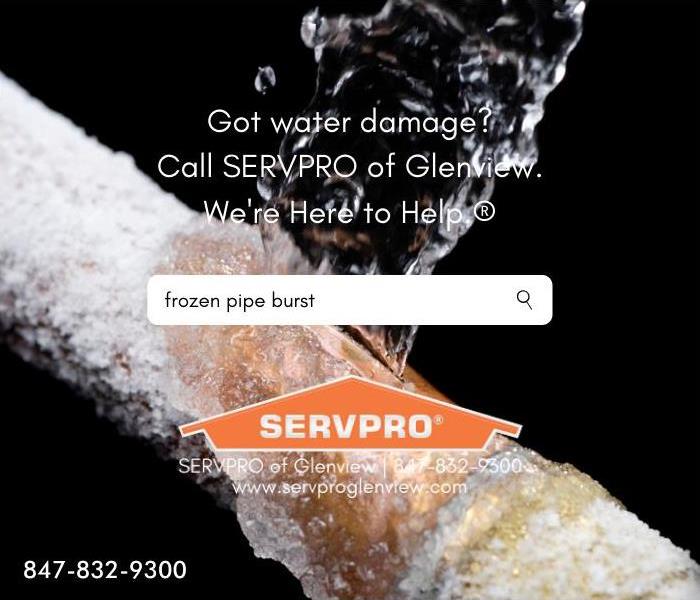 Frozen pipe burst? Search no further - call SERVPRO of Glenview at 847-832-9300!
Frozen pipe burst? Search no further - call SERVPRO of Glenview at 847-832-9300!
Are YOU prepared for the polar vortex? Is your HOME winter-ready?
Arctic Air to Bring Dangerous Cold This Week
With the temperatures dipping below zero this month with the incoming polar vortex, if you haven't already done so, it's imperative to take preventative measures now to protect your water pipes from freezing and subsequently bursting.
We all know water expands as it freezes. If the water inside your pipes freezes, it will expand which can cause your pipes or connections to crack and burst. Water pipes can also burst when pressure builds up behind a chunk of ice, which is why it has long been suggested to leave faucets dripping in extremely cold weather. Whatever the situation that causes a burst pipe, you can end up with extensive water damage.
Pro Tip: Know where your water shutoff valve is so that you can turn off the water in case a pipe bursts! Typically it's located in the basement or buried near the road. Knowing where that valve is located can save precious time when you've got water spraying everywhere and causing damage to your home and belongings.
Take a few steps to prepare and avoid a potential catastrophe:
- Look for areas where your water supply lines are exposed, such as under kitchen and bathroom cabinets:
- Both hot and cold water pipes in these areas should be insulated;
- If you do not have time to insulate them before freezing temps move in, leave the cabinet doors open to let the warmer room temperature to circulate around the exposed pipes.
- Consider installing specific products to insulate exposed water pipes, as each can greatly reduce the likelihood of those pipes freezing and bursting:
- Foam pipe sleeves;
- UL-listed heat tape;
- heat cable or similar materials.
- Protect water pipes that run through unheated areas of your home with insulation; these would be pipes in exposed areas such as your attic, basement, or garage.
- If you haven't already done so:
- Disconnect and store outdoor hoses;
- Drain water from outdoor faucets;
- Cover outdoor faucets with foam insulators;
- Drain sprinkler systems to keep buried pipes from freezing.
Make it an annual chore each fall to take preventative measures by doing regular home maintenance such as draining exterior water lines, or by insulating and protecting exposed pipes. When the frigid temps of winter come, you will rest easier knowing you have taken steps to prevent your pipes from freezing.
Should the unthinkable happen and your water pipes freeze and then burst, know you can count on SERVPRO of Glenview to respond to your call for help with the resulting water loss. Call us 24/7 at 847-832-9300. Whether your winter water damage is a result of a burst pipe, a frozen water dam in your gutters, or a failed appliance, our SERVPRO team of technicians are always Here to Help®.
Heavy Snows Can Lead to Residential Water Damage
1/29/2021 (Permalink)
Like any typical January here in the Midwest, we've seen a snowfall or two, yet it's likely the heaviest snow or biggest snowstorm of the season is looming on the horizon.
During these Midwest winters, it is important to remember that heavy snow build-up on your roof has the potential to cause a lot more damage than just a cave in!
Snow loads on your structures can lead to several immediate problems, including roof sagging, roof cave-in, ice dams, sagging gutters, or melting snow leaking into your attic space. All of these have potential for long term damage.
To prevent any possibility of water damage or mold damage from occurring in your home's attic and interior spaces, be proactive in handling any snow build-up on your roof.
If you yourself cannot safely clear the snow from the roof using a roof snow rake, then call snow removal professionals who can take away the snow piled on your roof safely and without damage to person or property.
Should the unthinkable happen and snow build-up on your structure causes water or mold damage, call the experts at SERVPRO of Glenview. We are Here to Help.® Call 847-832-9300.
3 Quick Safety Tips When Dealing With Snow and Ice
12/21/2020 (Permalink)
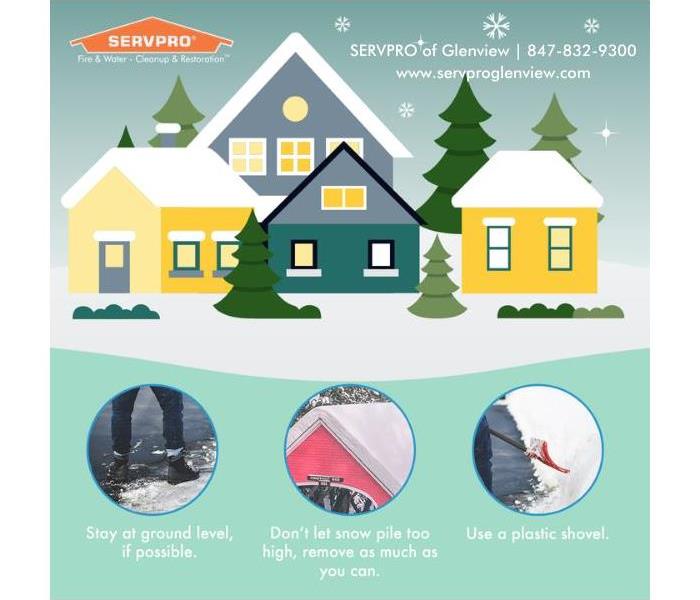 3 quick safety tips to remember when dealing with snow and ice this winter at your home or business
3 quick safety tips to remember when dealing with snow and ice this winter at your home or business
Winter storms bring their own set of dangers for homeowners. If your area gets a significant amount of snow, there are steps you should take to prevent damage to your property, be it residential or commercial.
A significant snowfall will accumulate on the ground as well as on physical structures, such as your house, garage, shed, office, and so on. Your task will be to clear the snow, keep access to the property clear of snow, and to do so safely.
Your first priority will be to clear the snow on the ground to provide clear access to your home's entry points, such as the walkway to your front door and the driveway or street leading to your parking area or garage.
Take a moment to look up! See how much snow is on your roof and determine the safest way to clear it. Don't let snow pile too high, as excessive snow can cause structural damage from the weight of the snow, in addition to potential water damage caused by ice dams in gutters or roof crevices, or from melting snow penetrating into the interior spaces, such as your attic.
Your safety should be your number one concern when clearing snow from your property! Here are the top three tips you should remember:
- Stay at ground level, if possible. This is the safest place for you to be. Ladders can become unstable on slippery, icy surfaces.
- Don't let snow pile too high, whether that's on the ground or on your roof or other overhead structures. Remove as much as you safely can.
- Use a plastic shovel, as metal shovels (or metal edges on shovels) can cause damage to your shingles, gutters, and siding. Better yet, use a roof snow rake - a tool meant to remove snow from roofs while the user stands safely on the ground.
If you cannot safely remove the accumulated snow from your property, be it snow on the ground or on your structure, call in a service to take care of it for you. Snow removal companies have the tools and manpower to safely clear the snow that has the potential to cause damage to your property, home, or business.
Snow left on the ground or roofs can go through several melt-freeze cycles, which creates a far more treacherous situation, as the underlying snow becomes compacted or turns into a thick sheet of ice. The dangers of this situation are numerous: snow and ice can cause people or animals to slip and fall on the ground; delivery persons can have difficulty accessing entry with packages or mail; snow or ice overhead can slide off, possibly onto and hurting persons below.
Proactive Steps You Should Take to Keep Your Pets Safe During Storms or Other Emergencies
11/18/2020 (Permalink)
 The team at SERVPRO of Glenview reminds you to keep your pets safe, especially during a storm or other emergency event
The team at SERVPRO of Glenview reminds you to keep your pets safe, especially during a storm or other emergency event
Don't forget about your pets!
Even the tv weatherperson is never accurate in predicting just how bad a storm will be, and it is even harder to know what kind of damage it will cause to your home. Amid all the chaos that you may be facing after storm damage - such as a leaking roof, a power outage, or a flooding basement - it can be easy to forget that your pets are also in danger.
Here are some simple and easy steps that you can follow to make sure your pet is as safe and secure as can be during emergency storms:
- Make sure that your pet is microchipped and has an ID tag on their collar, whenever possible. Of course, it’s important to keep pets indoors and in a safe environment, but sometimes loud noises can frighten them and, depending on the pet, lead them to attempt an escape.
- Keep extra food and clean water in a safe, water-proof area. It’s possible that your water supply could be shut off or contaminated, and so you should keep some handy just for your animal friend.
- Give your pet medication, a thunder vest, or whatever else they need to keep their anxiety down. Make sure you check in with a vet before you decide on any medications. If they have a space where they feel safe, make sure it’s available to them.
- Have a contingency plan for their bathroom needs. In extreme cold, rain, or storms, you may not be able to take your pet out. If you have a cat, keep a clean box, and for dogs you can use sanit-pads in the bathroom or any other waterproof areas.
These are a few, simple guidelines that we hope can help you create a safe environment for your pet during emergency situations. Still, you know your pet and their needs best, so keep their safety in mind amid all the many things that you may be dealing with following a damaging storm event.
Should the storm damage have caused a flood in your home, it’s always a good idea to call a professional in case any dangerous molds, bacteria, or other pathogens are present, which are harmful to both pets and humans.
If you have any questions, we are Here to Help®! Call SERVPRO of Glenview at 847-832-9300.
Severe Weather Preparedness
3/3/2020 (Permalink)
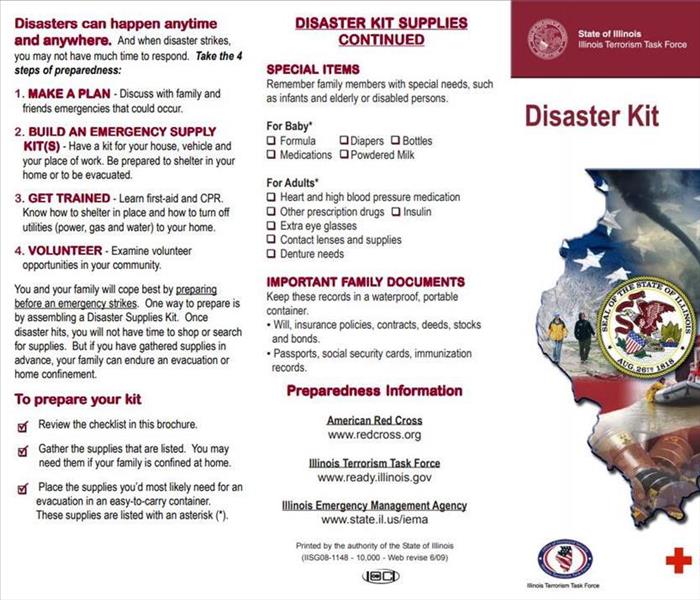 Preparing a Disaster Supplies Kit is essential to helping you best survive an emergency!
Preparing a Disaster Supplies Kit is essential to helping you best survive an emergency!
March 1-7, 2020 is Severe Weather Preparedness Week in Illinois.
Being prepared and informed saves lives!
Severe weather is not something we can stop or control. From thunderstorms to lightning, tornadoes to floods, we cannot control when or where they develop or strike. However, there are things we can do to minimize the impact of severe weather.
- Stay informed! Have various means of being alerted of severe weather in your area! Monitor a weather alert radio. Listen to local radio broadcasts. Watch local TV. Follow NWS (National Weather Service) web pages and apps for updates. Sign up for and receive alerts and notifications from various weather apps on your computer and smart phone. The important thing is to NOT rely on just one method! Even though storm sirens are a great alert system, they are not designed to be heard indoors by everyone.
- Have an emergency plan! Whether at home, at work, or at school, or when you travel, there should be an emergency evacuation plan in place. Not only should there be a plan - but you should practice your plan too! Designate places to go to seek safe shelter from a tornado or severe thunderstorm. Pick two places to meet, in case the first is not available or accessible - and meet your family, friends, or co-workers there in case you are separated. If you are traveling, know the names of locations you are visiting - and make sure your children know them too.
- Prepare yourself AND your home for an emergency! Inspect your home for potential hazards (such as weakened tree limbs, worn roofing, cracked windows, improper landscape grading) and address these issues before storms magnify the damage. When you build a new structure or renovate an existing one, there are ways to prevent wind damage to roofs, upper floors, and garages. Rafters, trusses, walls, and doors can all be reinforced. Learn how to react in an emergency: learn how to administer CPR; learn how to use a fire extinguisher; learn how to turn off the electricity, gas, and water supplies in your home.
- Have an emergency supply kit ready and available! Some storms produce power outages that have the potential to last for several days. Have an emergency hit with at least these following items ready so you are better able to cope with the disaster:
- Bottled water
- Non-perishable food
- Flashlights & extra batteries
- Extra clothing & blankets
- An extra set of house keys
- Cash
- Medications & personal hygiene items
- First Aid kit
- Pet supplies (if applicable)
- A weather alert radio or portable AM/FM radio
- A written list of contacts and other information you may need in an emergency, including: personal contacts (family, friends) - phones and addresses, doctors/medical centers, bank account info, credit card account number and provider info, numbers for utility and mortgage accounts and providers, insurance policy info.
- If your computer, tablet, or mobile device are not accessible, or if the internet is not available, you may not have access to stored contacts and information! Be prepared and have a written list of this information available and ready to take with you in the event of an emergency.
- If you have children, try to have an updated photo of them printed out. Should your child or children somehow become separated from you, it will ease your mind a little knowing you have a photo to give to emergency personnel (police, fire, medical personnel, EMTs) should they need to search for your child or children. (The same can be said for elderly relatives who may have dementia - have a photo of them in case they become separated from you).
Everything boils down to two words: BE PREPARED!!!
This is what Preparedness Weeks are all about! Learn about what Severe Weather is prevalent in your area, arm yourself with information how best to survive, and prepare yourself!
Preventing Ice Dams
1/24/2020 (Permalink)
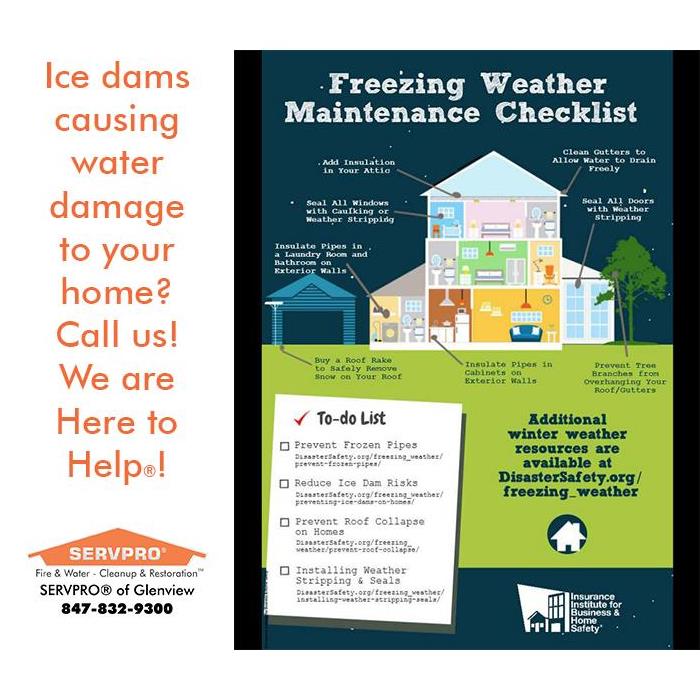 Don't wait til it's too late to prevent ice dams - but if you get water damage, be sure to call on SERVPRO® of Glenview!
Don't wait til it's too late to prevent ice dams - but if you get water damage, be sure to call on SERVPRO® of Glenview!
Winter weather can wreak havoc on a home. For instance, snow or ice-covered walkways and driveways can become a hazard for people if they are not cleared right away. For the safety of your family, pets, and vehicles, we're sure you clear the snow from all areas and perhaps put down salt to melt the ice.
Just as you clear snow and ice from the walking paths around your home in the winter, homeowners need to remember to look up and check your roof as well!
Not only can the weight of accumulated snow or ice on your roof become a hazard when not cleared, but it can lead to the buildup of ice dams. Why is that a bad thing? Ice dams can cause water to leak into your home, potentially causing damage to everything from the exterior walls and roof to the interior walls, ceilings, and even structural components like joists or studs. Water leaking into your home could also damage your personal belongings. Additionally, water damage left unresolved could lead to mold, which is something no homeowner wants to deal with.
Read below for tips on preventing ice dams. If you missed our post on preventing roof damage, you can read it here: http://bit.ly/SPGV20200121
Protect Homes from Winter Weather: Preventing Ice Dams
1. Keep roof drainage systems clear! This means keeping all drains, gutters, and downspouts free of debris and vegetation that may restrict proper flow.
2. Consider heat sources - remove or relocate heat sources that are installed in open attic areas directly under the roof.
3. Insulate light fixtures in the ceiling below an unheated attic space.
4. Insulate attic penetrations: if you have penetrations into the attic, such as vents, seal and insulate them so that daylight cannot be seen and airflow is minimal.
5. Install heating cables on eaves, gutters, and downspouts or around roof drains on flat roofs. This will not remove an existing ice dam, but will create effective channels that allow water to drain off safely.
https://disastersafety.org/winter-weather/protect-your-home-from-ice-dams/
Protect Homes from Winter Weather: Preventing Roof Damage
1/21/2020 (Permalink)
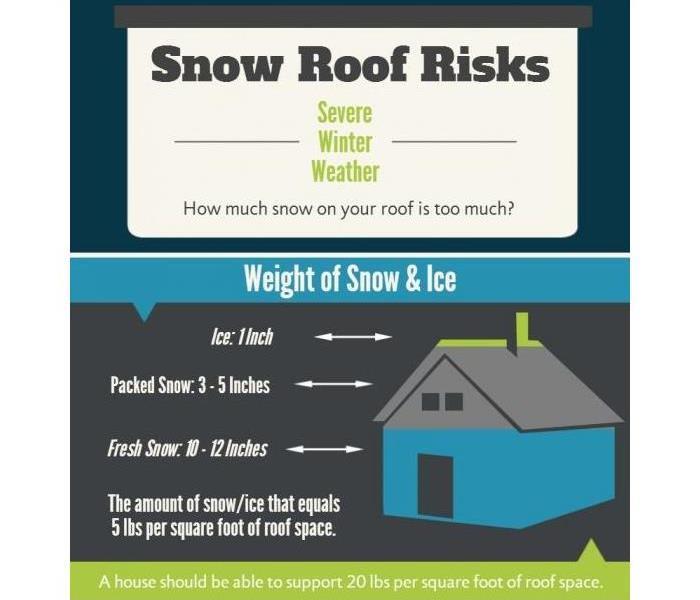 How much snow on your roof is too much?
How much snow on your roof is too much?
They say "knowledge is power." This is so true when it comes to homeownership!
Don't wait until winter weather has hit your hometown in full force to begin arming yourself with knowledge! Knowing what to do, what not to do, and when to do it are key pieces of information to have in any situation. With winter weather either already here and more snow and ice on the way, here are some tips for homeowners. Know what it takes to prevent roof damage from snow and ice.
1. Evaluate your risk! Melting snow tends to more quickly run off steep sloped roofs with slopes greater than 3" of slope in 12" of horizontal distance (3/12 pitch or greater), particularly the steeper ones that are typically found on houses in northern climates. Ice and snow tend to more readily accumulate on low slope and flat roofs over porches or parts of a home that are next to a taller section of the house, expecially during high winds.
2. Estimate how much weight your roof can support! Unless the roof structure is damaged or decayed, most residential roofs regardless of the location of the house should be able to support 20 pounds per square foot of snow before they become stressed. If you live in an area known for lots of snow, we recommend checking with your building department to find out of higher loads were used at the time your home was built, to see if your roof may be able to resister a greater depth of snow.
3. Estimate how much the snow on your roof weighs! Here are some general snow weight guidelines:
- Fresh snow: 10"-12: of new snow is equal to 1" of water, or about 5 pounds per square foot of roof space; so you could potentially have up to 4 feet of fresh snow before the roof will become stressed.
- Packed snow: 3"-5" of old snow is equal to 1" of water (5 lb/sq.ft. of roof space), so anything more than 2 feet of old snow could be too much for your roof to handle.
- Ice: 1" of ice equals 1 foot of fresh snow, or 1" of ice is equal to 1" of water, or about 5 pounds per square foot of roof space.
- Total accumulated weight: 2 feet of old snow and 2 feet of new snow could weigh as much as 60 pounds per square foot of roof space, which is triple the typical snow load capacity of most roofs!
4. Remove the snow from your roof! If the loads you estimate based on the thickness of various types of snow and ice exceed 20-25 pounds per square foot, you should consider removing snow from your roof. For safe removal that won't endanger you or damage your roof, hire a snow removal contractor who can safely remove the snow and ice.
These tips come courtesy of the Insurance Institute for Business & Home Safety.
If your home suffers damage from snow or ice on the roof which leads to water damage inside the structure, call on SERVPRO® of Glenview to come clean up the wet mess. 847-832-9300
Mold damage and foul odors
11/17/2019 (Permalink)
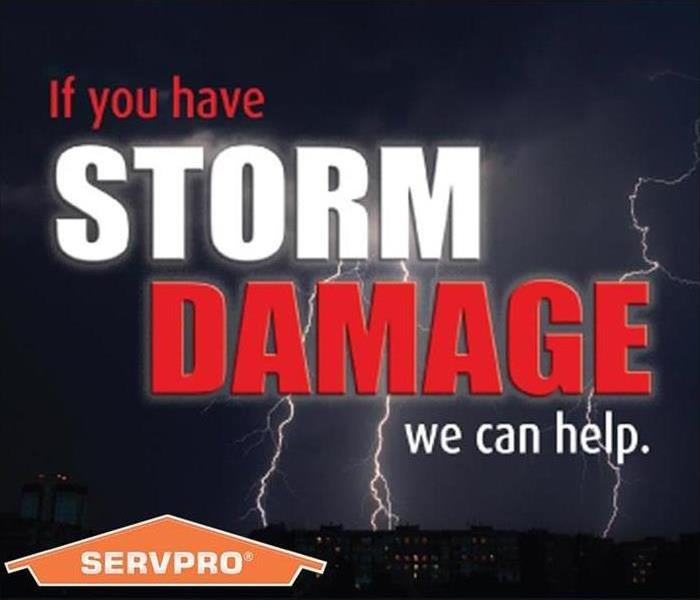 Storms can wreak havoc on your home or business. If you're trying to cleanup flood damage, call SERVPRO of Glenview. We're Here to Help®! 847-832-9300
Storms can wreak havoc on your home or business. If you're trying to cleanup flood damage, call SERVPRO of Glenview. We're Here to Help®! 847-832-9300
There are a number of ways that your home or business can sustain damage after a storm. The storm itself can wreak havoc with strong winds and flying debris, but most often, it is the flood damage that causes most damage. In the aftermath, the storm damage must be removed as possible to avoid permanent damage to the structure, as well as avoiding mold infestation and the resultant foul odors.
Why SERVPRO?
When a severe water loss occurs in your home or business, time is of the essence to cleanup the damage. It is crucial to utilize a professional restoration service with local, certified technicians. Groundwater may contain contaminants; before coming into contact with it during flood damage cleanup, our SERVPRO technicians test the water to determine what they are dealing with so they choose the best methods for mitigation. Our SERVPRO team members work hard to assist Glenview neighbors and community members in limiting loss from floodwater by using their extensive training and state-of-the-art equipment.
Complete Drying Limits Odor
Controlled demolition is a standard action during flood damage cleanup. This type of removal of building materials is exacting because our SERVPRO crew only takes out the damaged materials while leaving behind the sheetrock and flooring which were unaffected by water loss. The removal of buckled or warped sheetrock allows for more airflow during drying, which not only inhibits mold growth but also diminishes odors in the home.
Odors May Indicate Mold
Mold has a tell-tale musty odor that gives away its presence. Technicians monitor water loss areas during and after the drying process to ensure that the air quality is well below sustainable levels for mold, as mold requires warmth over 70°F and high humidity levels to flourish. Areas where our crew finds mold growing are abated and treated with antimicrobial sealants to inhibit any return.
Removal of Residual Water Odors
After flooding occurs and after the complete drying process, sometimes there are residual water odors left behind. When antibacterial solutions do not eliminate the odors, SERVPRO technicians have a diverse array of odor neutralizing applications to use until they eradicate the odor from the property.
You do not have to live with odors continually reminding you of the flood damage that occurred to your home or business. Contact SERVPRO of Glenview at 847-832-9300 and our team of certified professionals can work to make the water loss and odor in your home "Like it never even happened."
"When thunder roars, go indoors!"
6/26/2019 (Permalink)
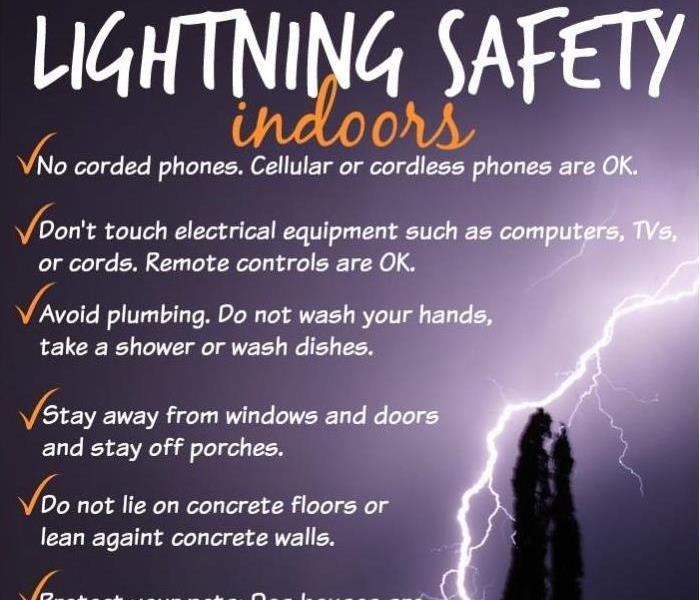 Lightning Safety Tips - Remember these tips on staying safe indoors during a storm that has lightning presence or potential!
Lightning Safety Tips - Remember these tips on staying safe indoors during a storm that has lightning presence or potential!
This last week of June is National Lightning Safety Awareness Week. If you follow our facebook page, then you've seen our posts this week about this annual effort to bring awareness to lightning safety.
There are quite a few reputable sources online where you can find information about lightning safety and what you can do in your home, your business, or your community to foster an awareness of the potential for storm damage. It's best not to be caught unaware, so educating yourself and others is key in preventing or minimizing any possible storm damage.
Check out these great websites that have helpful information on lightning safety:
This graphic from the National Oceanic and Atmospheric Administration summarizes what to do when you hear the thunder of an approaching storm.
"When thunder roars, go indoors!"
While this is excellent advice because you are significantly safer indoors during a thunderstorm than you are outdoors, you are still not immune to lightning danger.
Since lightning can strike and travel through different channels that could still reach you indoors, here are some tips to keep your risks to a minimum.
- Do not use corded telephones or other plugged-in appliances! This includes electrical equipment such as computers, TVs, and kitchen appliances like your microwave. Using your cell phone is safe - so long as it is not being charged while you're using it!
- If you are going to unplug any electrical devices to protect them against possible power surges, be sure to unplug them before the storm begins! You don't want to be touching those electrical cords when there is a danger of lightning striking!
- Avoid plumbing, as both water and metal plumbing can conduct electricity from a lightning strike. Take your shower, do your laundry, or wash dishes after the storm has passed.
- Stay away from windows and doors, as they can have small cracks in the frames that could allow lightning in.
- It should go without saying that if you are seeking safety and shelter indoors, you should avoid going out on to porches or balconies.
- Refrain from touching concrete surfaces such as the walls or flooring of your basement or garage - lightning can travel through the metal wires or bars which are used in concrete construction.
- Protect your pets! If you have pets outdoors, bring them inside with you when you seek shelter from the storm.
Remember the 30/30 Rule: If there is less than 30 seconds between a flash of lightning and the sound of thunder, you should seek shelter. Wait at least 30 minutes after the last clap of thunder before leaving shelter if you must go outdoors.
Discuss storm safety and the dangers of lightning with your family so everyone is aware of what to do - and not to do - during a storm. #NationalLightningSafetyAwarenessWeek is a great time to remind everyone of storm safety.
SERVPRO of Glenview wants everyone to be safe during a storm, but if your home suffers #stormdamage, remember that we are #HereToHelp. If you need our fire & water cleanup & restoration services, call 847-832-9300 or visit us online at www.SERVPROglenview.com.
Tornado Preparedness.
5/14/2019 (Permalink)
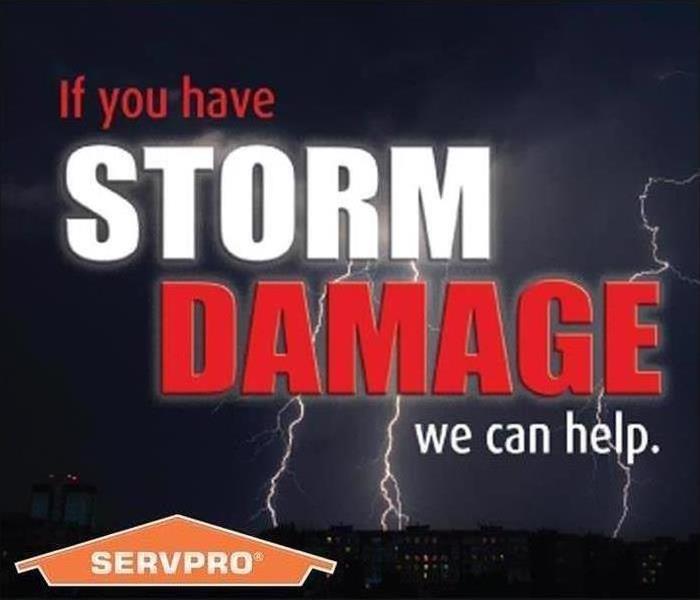 1,200 tornadoes on average hit the U.S. Will you be ready when one hits your town? Call SERVPRO of Glenview for your storm damage needs!
1,200 tornadoes on average hit the U.S. Will you be ready when one hits your town? Call SERVPRO of Glenview for your storm damage needs!
Some things you should know about tornadoes:
1. Most move southwest to southeast, however, some change direction or even back track.
2. Tornadoes do not only appear as funnel clouds.
3. Tornadoes can accompany tropical storms and hurricanes once on land.
Prepare yourself for Spring.......STORMS!
2/26/2019 (Permalink)
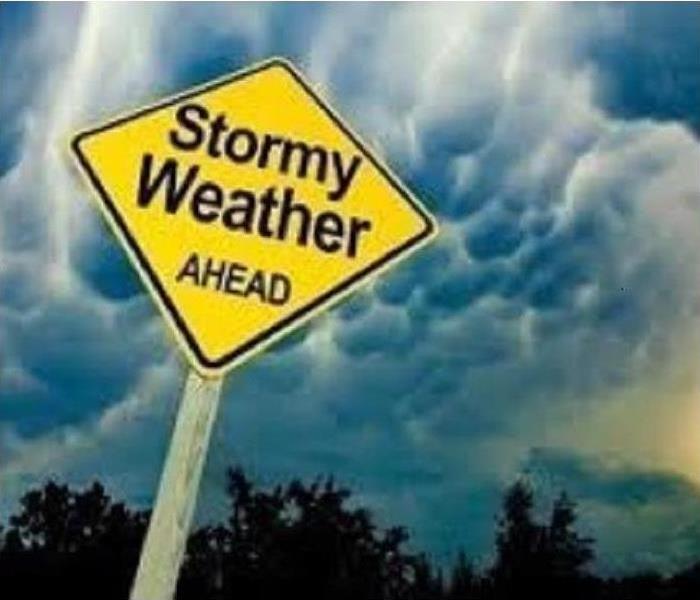 Spring can be devastatingly beautiful or just devastating!
Spring can be devastatingly beautiful or just devastating!
From thunderstorms spawning high winds to flooding and tornadoes, spring storms can bring tremendous property damage.
Hailstorms cause almost $1 billion in property damage each year, according to the Insurance Information Institute. Losses for severe thunderstorms in the U.S. have increased sevenfold since 1980, reaching almost $15 billion last year, according to Munich Re, the world's largest reinsurer.
While it's true that it's difficult to predict Mother Nature, you can take steps ahead of time to prepare your home for spring storms, minimize damage and keep your family safe. Use these tips to prepare for whatever Mother Nature has in store this season:
- Prune dead or rotting branches from trees near your home or car that could fall during a storm.
- Stock an emergency kit with water, non-perishable food, a first-aid kit, flashlights and extra batteries, and a battery-operated radio in case of a storm-related power outage.
- Use surge protectors for electronic equipment in your home such as computers, televisions and appliances.
- Install a lightning protection system that will redirect lightning strikes safely into the ground.
- Know how to shut off the power to your house using the main fuse or breaker on the electrical service panel, and how to shut off water and gas support lines if instructed by disaster officials.
- Learn about flood insurance at floodsmart.gov. Floods and flash floods occur in all 50 states and most homeowner’s insurance policies do not cover flood damages — even an inch of water can cause thousands of dollars in damage.
- Check the condition of your roof and make any needed repairs to minimize damage in a storm. Clean gutters and downspouts so water will be diverted away from your home.
If a storm is approaching, stay up to date on the latest weather conditions and heed any warnings or evacuation orders.
If a storm is imminent, it's time to batten down the hatches right away and think safety:
- Use your TV, radio or the Internet to stay up to date on changing weather conditions. Know the difference between a storm watch and the more serious storm warnings issued by the National Weather Service.
- Tie down or bring inside anything that could be blown around such as trash cans, barbecue grills and outdoor furniture.
- Get inside and close your windows and doors. Pull the blinds and drapes so that if glass is broken, it's less likely to fly into the house.
- Unplug expensive electronic equipment.
- Set your refrigerator and freezer to the coldest setting. In case of a power outage, food will be colder and last longer.
These steps can help you feel prepared for the uncertainty of spring storm season.
Remember that if you should be hit by a damaging storm, SERVPRO of Glenview, at 847-832-9300, is here to help. "Like it never even happened."
7 Tips to Get Your Home Ready for Cold Weather
11/27/2018 (Permalink)
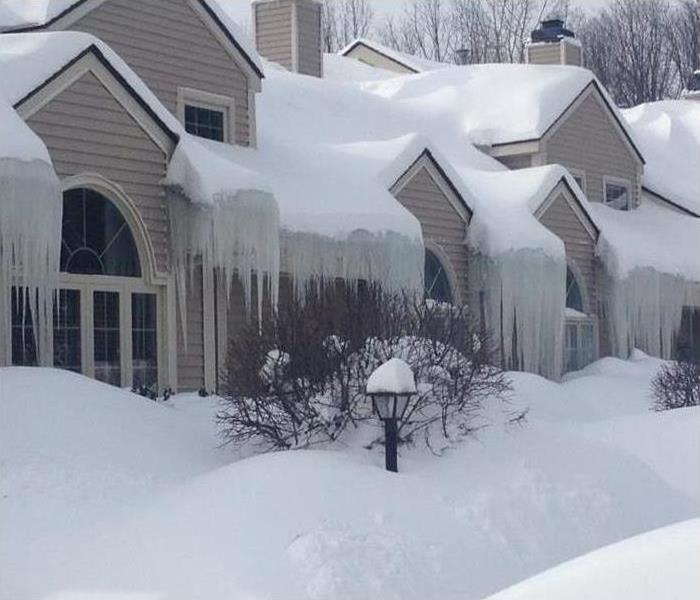 Protect your home from winter storms
Protect your home from winter storms
Stay warm, save money and prevent damage to your home from cold and snow with these simple steps.
As cold weather approaches, there are several things you can do around the house to make sure you and your family stay warm and safe all winter. These seven steps can ensure your house will be in top shape for whatever winter brings.
1. Protect Your Pipes:
We all know water expands as it freezes. If water inside your pipes freezes, it will expand, too, which can cause your pipes to crack and burst. Pipes also can burst when pressure builds up behind a chunk of ice, which is why it's a good idea to leave faucets dripping in very cold weather. Either way, a burst pipe can cause massive damage. Take a few steps to winterize your pipes and avoid potential catastrophe.
- Drain water from outdoor faucets and sprinkler systems to keep those pipes from freezing.
- Disconnect and store outdoor hoses; cover outdoor faucets with foam insulators.
- Protect water pipes that run through unheated areas of your home with insulation, such as the attic, basement, or garage.
Pro Tip: Know where your water shutoff valve is so that you can turn off the water in case of an emergency. Typically it's located in the basement or buried near the road.
2. Check the Heat:
The time to be sure you're going to stay warm all winter is before the weather gets too cold. Check your furnace by turning on the heat and the blower to be sure they're operating as they should.
- Change your furnace filter at the start of the season and then every two to four months. Filters get dirty much more quickly if your home is dusty or if you have furry or feathery pets. Clogged or dirty filters are less efficient, which means your home might not warm up properly.
- Consider installing a programmable thermostat if you don't have one. Programming it to be cooler at night and when you're not at home will save you money, and you can program it to be warmer for when you return or get up on cold winter mornings.
Pro Tip: Reverse the direction of your ceiling fans. Everybody thinks of using fans in the summer, but they can help you stay warm in winter too. Set the blades to turn clockwise to circulate warm air from the ceiling down into the room.
3. Prevent Ice Dams:
Ice dams form when heat escapes through the roof and melts snow that's settled there. That snowmelt flows to your roof's edge and refreezes, usually at the eaves. Those pretty icicles can signal an ugly ice dam underneath. The problem with an ice dam is that snow that later melts can't properly drain, so it has to go somewhere… and that might be through a leak in your roof, causing water damage in your home.
Fortunately, a few simple steps before the temperature starts to drop can go a long way toward preventing all of this:
- Clogged gutters and downspouts are the No. 1 cause of ice dams. Clean them out to keep water flowing during the winter.
- Seal places that may allow warm air to leak from your home to your attic, such as around vent pipes, exhaust fans, chimneys, attic hatches, and light fixtures.
- Be sure soffit vents, which are along the eaves of the house and allow air to flow into the attic, are clear.
If you've had problems with ice dams before or have reason to suspect you might this year, you can take these additional steps:
- Install snow and ice slides to prevent ice and snow from "bonding" to your roof.
- Install a rubberized ice and water shield beneath the roof shingles, going three to six feet back from the eaves.
- Hire a roofer to install heat cable along the eaves to melt ice.
- Add additional insulation to your attic floor.
4. Clean and Store Lawn Equipment:
After a summer of yard work, gas-powered equipment such as mowers, trimmers, tillers, and chippers can all benefit from service before being stored for the winter. This basic checklist will get you started on equipment maintenance, but be sure to check the owner's manual for any specific requirements for your machines.
- Empty all of the fuel. Gas can degrade all the time, and the ethanol in E10 gas can damage fuel lines and other components while sitting unused. Try to use up most of the fuel during the last mowing of the season. You can remove what’s left with a meat baster, then run the engines until they stop. Check with your local waste management or public works department for guidance on how to dispose of the fuel.
- Clean the machine of oil and yard debris, and sharpen the blades.
- Store them for winter in a basement, garage, or covered storage shed where they're safe from the weather.
5. Inspect the Fireplace and Chimney:
There's nothing like the glow of a fire to warm up a winter evening. But before you light up that first log, make sure your fireplace and chimney are clean and critter-free.
A professional chimney sweep can clean out soot and other debris that could catch fire. Keep your home's warm air from escaping out the chimney when you're not using it by keeping the flue closed all the way. You shouldn't be able to feel any cold air coming down the chimney.
You can also install glass fireplace doors or a chimney inflatable that blocks cold air from coming down the chimney and keeps in warm air.
6. Seal Windows and Doors:
Gaps around windows and doors can make it tough to keep your house warm in winter. Caulk around windows and install weather stripping around doors as needed. This minor and inexpensive task can help you save on heating costs.
If your windows and doors are older, they may be inefficient single-pane windows or uninsulated doors. Consider upgrading to double- or even triple-pane windows and insulated doors and garage doors to boost the energy efficiency of your home.
Another option is to add storm windows and doors. Remove, wash and store screens for the spring before you have them installed.
7. Stock Up on Cold-weather Essentials:
When winter storms hit, they often come with power outages. To ensure you and your family are prepared for anything Mother Nature throws at you this winter, you will want to have an emergency kit ready. Explore this one for ideas of what to put in it, and consider having these cold-weather specific items on hand as well:
- A working, fully charged fire extinguisher.
- An alternative heat source such as a generator, wood-burning stove, or fireplace.
- Sand, ice melt, and a shovel if where you live is prone to ice and snow (avoid using kitty litter, as it doesn't provide good traction and can make a mess).
You should also develop a plan for communicating or meeting up with family in case you aren't together when a winter storm hits.
And get your car ready too. Whether you live in a cold-weather climate or just plan to visit one, you will want to keep these essentials in your car for winter-weather emergencies.
A storm or power outage in winter can be dangerous, even when you’re in your car or home. Be prepared this winter to weather the storms and cold.
Remember that if you do have damage in your home caused by winter weather, call SERVPRO of Glenview at 847-834-9399 and we will restore it "Like it never even happened"!
SERVPRO of Glenview - Panama City Bound!
10/22/2018 (Permalink)
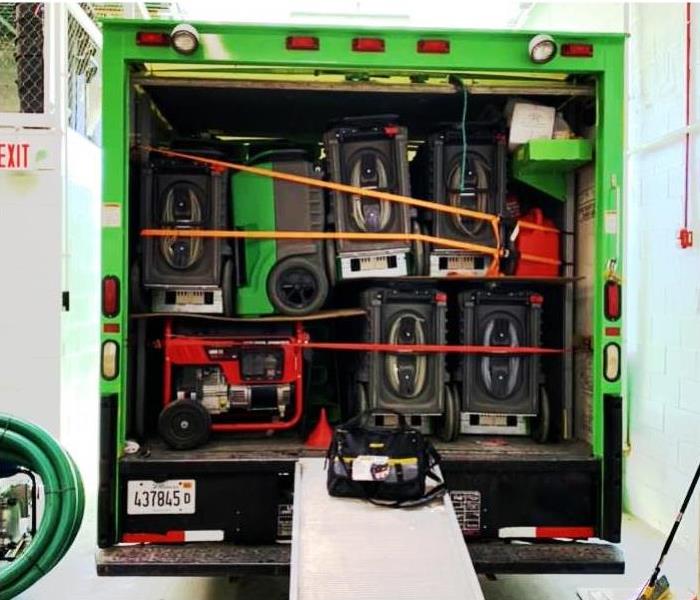 We are prepared to handle Hurricane Michael's devastation!
We are prepared to handle Hurricane Michael's devastation!
SERVPRO is rallying crews from all over the country to help restore the Florida Panhandle back to its beautiful self, again.
SERVPRO of Glenview dispatched a crew to assist in the restoration after the devastation Hurricane Michael wrought on the Gulf Coast earlier this month.
It has been a year of devastating hurricanes. From the crushing impact of Hurricane Harvey in 2017 in the Gulf Coast to Hurricane Florence in North Carolina, and now Hurricane Michael in Florida, you may never think that you will be affected…until it happens to you.
Facts about Hurricanes
- On average, the U.S. Eastern Coast experiences 10 tropical storms a year.
- They form from warm waters over the Atlantic Ocean, and under right circumstances, develop into massive hurricanes, circulating at 180 MPH.
- They can last for 2 to 3 weeks before they even making landfall.
- Hurricanes can cover miles in circumference, increasing the mass area for destruction.
Hurricane Michael
Hurricane Michael made landfall in Mexico Beach, Florida on the afternoon of October 10, 2018. Hurricane Michael’s winds were at 155 MPH, the category 4 hurricane close to being a category 5 and the most powerful hurricane since 1992. The Florida panhandle was left in ruins and devastation.
What Can SERVPRO do for you?
SERVPRO of Glenview specializes in the cleanup and restoration of commercial and residential property after damaging event. Our staff is highly trained in property damage restoration. From initial and ongoing training at SERVPRO’s corporate training facility for regular IICRC-industry certification, rest assured our staff is equipped with the knowledge to restore your property.
Winter Weather Can Lead to Bursting Pipes
2/12/2018 (Permalink)
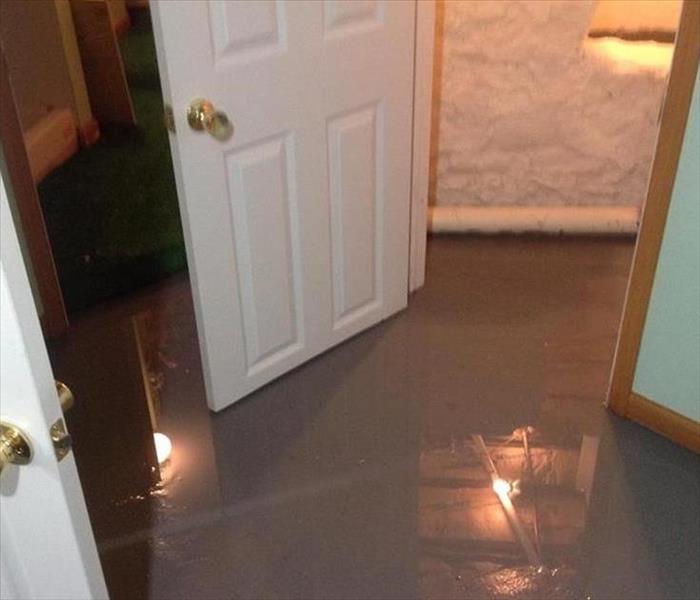 This flooded basement was cause by a frozen pipe that burst.
This flooded basement was cause by a frozen pipe that burst.
The cold Chicago winters can lead to many different types of problems for a home. 1 such problem is that of busted pipes. A busted pipe can lead to serious flooding of a home.
Here is a before photo of just how severe the damage can be. Lucky for this Glenview resident, SERVPRO of Glenview was just around the corner and was able to mitigate the loss with minimal damage. After the clean up efforts were completed, the home owner was very pleased and even referred SERVPRO of Glenview to her place of business for additional restoration work!!
Discount of flood insurance in Glenview?
11/13/2016 (Permalink)
At SERVPRO of Glenview we have seen our fair share of flooded homes.'
If you do not have flood insurance, talk to your insurance agent. Most homeowner’s insurance policies do not cover damage from floods. Flood insurance is only available to those participating communities in the National Flood Insurance Program (NFIP). Because of our floodplain management programs that attempt to protect us from the multiple flooding hazards, Glenview is part of the NFIP and, thus, residents are able to obtain flood insurance. Additionally, because the Village participates in FEMA’s CRS program, flood insurance premiums are discounted.
Make sure to check your policy to ensure you have adequate coverage. Usually these policies cover the building structure, but not the contents. There is a 30-day waiting period before flood insurance coverage becomes effective. Plan ahead; do not wait until a flood is predicted before purchasing flood insurance.
If you are building inside the floodplain, the purchase of flood insurance is mandatory if using a federally regulated/insured bank for a loan. In the unfortunate situation your home or business does flood, rest assure SERVPRO of Glenview is only a phone call away. 24 hours a day 365 days a year we are here to serve you and make it "Like it Never Even Happened!"
847-832-9300





 24/7 Emergency Service
24/7 Emergency Service











